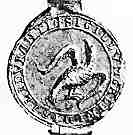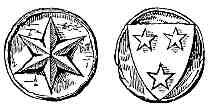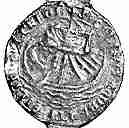





If you are looking at this page without frames, there is more information about medieval writing to be found by going to the home page (framed) or the site map (no frames).
| Seals of the Gentry | |||
| For those free persons with a bit of rural property who were not sufficiently far up the social ladder to justify having a grand equestrian seal or who, at a later date, did not qualify for elaborate heraldry, a range of designs was employed on seals of modest size. They followed the basic system of having an image surrounded by an inscription, and could be round or pointed oval in shape. The image could include plant or animal forms, including fabulous animals from the bestiary. | |||
 |
This seal on a modest grant of land to Oseney Abbey bears the image of a bird with wings outstretched. | ||
| Late 12th century seal of Geoffrey son of Durand (Christ Church, Oxford). (From Salter 1929) | |||
 |
|||
| Seals of John de la Harlotera, John of Pollertoft, Richard of the Castle and Solania. | |||
| The assortment above shows the miscellany of motifs that could be employed when the owner was not bound by the rules of status or heraldry. Designs comprise a plant motif, a funny little rabbit, two birds flanking a plant motif and a six pointed star. Sometimes, if the family moved upward in status over time, such informally claimed motifs might be incorporated into official heraldic designs. | |||
 |
At left, seal of William Innes, or De Ynays, of 1295. To the right the seal of Walter Innes, of 1431, displaying his shield of arms of three blue mullets on a field of silver. | ||
| In this example, the star design used on a 13th century seal has become part of the official family coat of arms by the 15th century. | |||
| Seals could represent a story. In the example at right, the graphic device is a boat with a square sail set, and on the left, rather difficult to make out, is a man steering with a paddle. This is supposed to be a reference to the conditions under which the manor of Padworth was held, the tenant being obliged to provide a man to hold a rope in the queen's ship when she crossed from England to Normandy. |
 |
||
| Seal of Robert son of Fulcred, of 1162, on a charter concerning the churches of Padworth (Queen's College, Oxford). (From Salter 1929) | |||
| Two French signets, at left the seal of Étienne Bricadel, treasurer to the countess of Artois, of 1314; at right the seal of Pierre d'Épine, master of hounds of the countess of Artois, of 1303. (From de Boüard 1929) | |||
| In the grand and competitive social hierarchy of the 14th century, status could be acquired by service to a higher status master or mistress. The two signets above are the personal seals of two servants of a countess, but that does not mean they were humble folks. The treasurer's seal at left shows a kneeling figure, so perhaps it represents a religious scene, or perhaps it is an expression of fealty - who knows? The one at right depicts a hunting horn, so it is definitely related to its owner's job description. | |||
 |
By the 15th century, the seals of some of the less significant gentry were simplified to an initial with a very small amount of simple graphic imagery. By this time, the mere possession of a seal was no longer a sign of status. Everybody needed one to carry out any form of legal transaction as legal and bureaucratic processes were now thoroughly in literate mode. | ||
| Seal of the early 15th century on a private charter from Yorkshire, formerly in a private collection. | |||
 |
Eventually, they might comprise a simple initial. While everybody who needed to carry out any form of written transaction required a personal seal, it is clear that the intricacies of individual seal design are no longer truly an authenticating instrument. After all, how hard would it be to forge this? The increasing bureaucracy in recording transactions was probably adequate to protect against fraud. The use of an indenture for a transaction also carried its own form of authentication. | ||
| Seal on an indenture of 1520 between two members of the Yorkshire gentry, formerly in a private collection. | |||
| These simple seals did not necessarily require anything very elaborate in the way of a seal matrix, which may well have been carved from bone or wood. | |||
| The use of seals moved rapidly down the social scale in the 12th and 13th centuries, as all forms of transactions and agreements had to be carried out through written process rather than oral agreement. There seems to be some doubt or dispute as to whether, or how much, this extended to the unfree or serf class. Supposedly charters or documents produced by these classes had no legal validity, but distinctions are rarely so absolute. Unfortunately, the lack of survival of documents from the lowest levels of the totem pole is a problem here. I suspect also that historical interest in the past has tended to focus on the docments of the higher echelons of society, as it has on their seals, which is why there are not so many illustrations in this section. | |||
If you are looking at this page without frames, there is more information about medieval writing to be found by going to the home page (framed) or the site map (no frames). |
|||